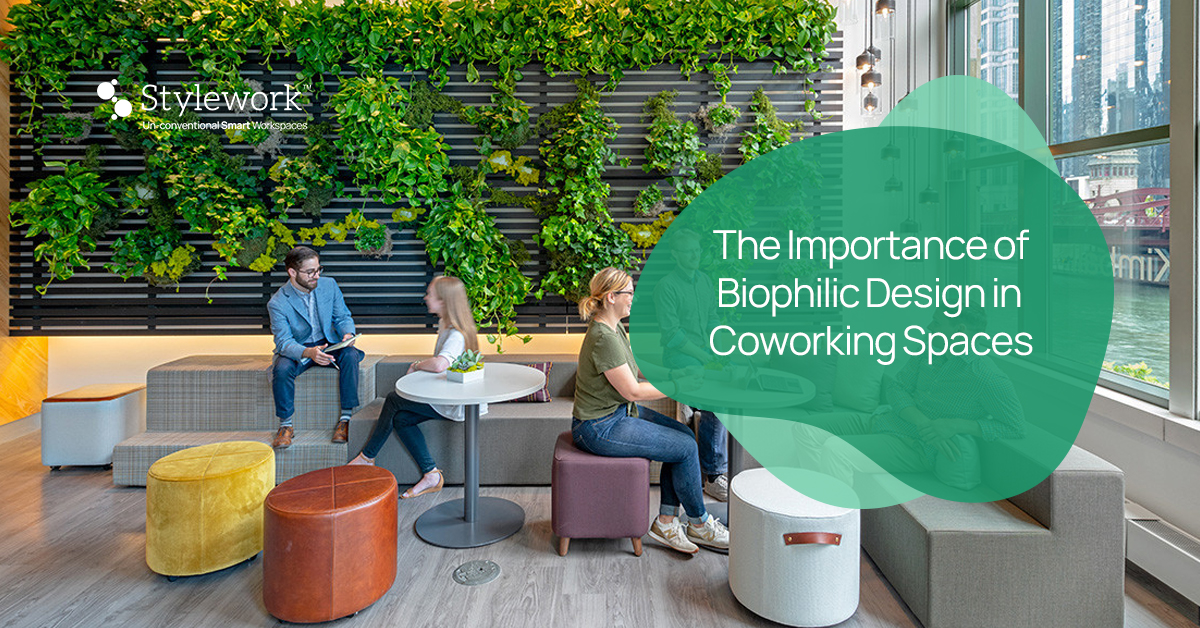As we mark Earth Day and look around at all the revolutionary strides being taken to conserve our planet, the importance of biophilic design in coworking spaces—in fact, all workplaces—is becoming apparent.
By integrating biophilic elements—such as greenery, sunlight, water features, and so on—into our workplaces, we not only foster our connection with the natural world but also align with Earth Day’s principles of environmental stewardship.
Principles of Biophilic Design
Now, biophilic design in workplaces is more than just putting plants in, despite it being one of the go-to solutions. Otherwise, here are some other principles of biophilic design.
- Optimizing natural lighting and outdoor views—integrating glass doors, ample windows, skylights, and so on—can be helpful.
- Choosing a soothing color palette inspired by nature, such as greens, blues, browns, and yellows.
- Including comfortable furnishings in outdoor areas so they can be utilized as additional workspaces further enhances employee well-being.
- Integrating natural shapes and forms, biophilic architecture is often associated with curved lines, arches, and domes.
- Incorporating natural elements, materials, and textures like wood, stone, and grass to imitate the outdoor environment.
The Workspaces of Today and Tomorrow
The evolution of our workspaces over the years has been nothing less than fascinating.
Today’s workplaces are increasingly focusing on sustainability, integrating elements such as energy-efficient lighting, recycled materials, and other sustainable building practices.
And with the multiple benefits of biophilic design in the workplace, the concept of biophilic design in office spaces is also gaining popularity. Biophilic elements in a workplace can include features like natural lighting, indoor plants, and living green walls.
As we look forward to the green workspaces of tomorrow, the emphasis on sustainability and biophilic design is bound to increase. This will especially be driven by the growing awareness of environmental issues as well as the desire for healthier, more inspiring workplaces.
What Are the Benefits of Biophilia in the Workplace?
Surrounded by giant concrete structures, people tend to yearn for more natural light, peace, calm and quiet, and most of all, the opportunity to be closer to nature.
Let’s look at some key benefits of biophilic design in the workplace.
1. Aids Physical and Mental Well-Being
Biophilic design is known to enhance the overall well-being of occupants. Incorporating natural elements into workspaces aids in reducing stress and boosting productivity.
In fact, studies showed that offices with biophilic interior design or elements reported 15% higher well-being and 6% higher productivity scores compared to those without.
On the other hand, natural light, ventilation, scenic views, and water elements further contribute to a calming and comfortable atmosphere.
Biophilic design in the workplace fulfills people’s desires for green workspaces and fresh air without having them leave the office premises.
Also Read: What is Hybrid Work?
2. Helps Sharpen Senses
As humans, we perceive our surroundings primarily through our senses, engaging with our environment through our senses of sight, touch, hearing, and smell.
Incorporating biophilic design in workplace helps stimulate these senses, thereby enhancing sensory experiences within workplaces and fostering a positive atmosphere.
3. Enhances Mind Restoration and Productivity
Our minds tend to seek comfort in simple, natural environments. Workplaces like coworking spaces, shared office spaces, managed office spaces, etc. with open windows, plants, and natural textures promote calmness, while cluttered areas with no natural elements can be overwhelming.
Also, with biophilic design, health benefits do come along. Including biophilic elements in workspaces helps reduce stress, blood pressure, and heart rates while enhancing productivity, creativity, and overall well-being.
Even research suggests that workplaces with just a few houseplants can boost productivity by 15%.
Also Read: How Coworking Spaces Promote Work-Life Balance
4. Increases Retention Rates
Biophilic design office spaces boost employee presence, engagement, and creativity, thereby reducing absenteeism and turnovers. Studies also show that workers in workspaces with biophilic interior design take fewer sick leaves in comparison to those in non-biophilic offices.
Integrating biophilic elements such as natural light and greenery not only increases productivity and happiness but also potentially improves employee health.
5. Helps Create a Stronger Bond With Nature
Biophilic design in workplace plays a major role in addressing our disconnect with nature by integrating natural elements into our workspaces.
Biophilic architecture not only improves environmental sustainability but also helps in re-fostering our connection with nature, which is an essential aspect of sustainable development.
Also Read: Hub-and-Spoke: Navigating Future Workspaces
Closing Thoughts
Biophilic design in workplaces is an essential factor in optimizing your coworking spaces. Through the integration of biophilic elements, you can create workplaces that are not only aesthetically pleasing and tranquil but also promote physical and emotional well-being among workers.
As a brand committed to providing you with your ideal workspace, Stylework enables individuals to discover and access flexi workspaces that fulfill all their requirements. Our extensive network of workspaces across the country ensures that you’ll always find a workplace where you and your team would love to work.
Contact us today, and let us help you find workspaces that inspire innovation, nurture collaboration, and cultivate success for all who inhabit them.
Frequent Asked Questions (FAQs)
1. What does biophilia mean?
The word biophilia finds its origin in Greek and literally means a love of life or living things.
2. What makes a biophilic design?
To put it simply, a biophilic design refers to the characteristics and elements of the natural world, such as natural lighting, plants, water features, etc., found in built-in environments.
3. What is biophilic design in the workplace?
Biophilic design in the workplace incorporates biophilic (natural) elements like plants, natural lighting, and outdoor views to enhance employee well-being, productivity, and creativity.

